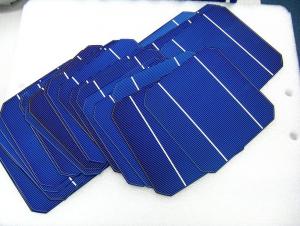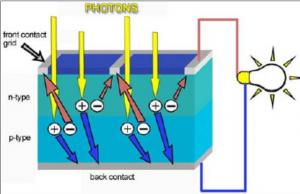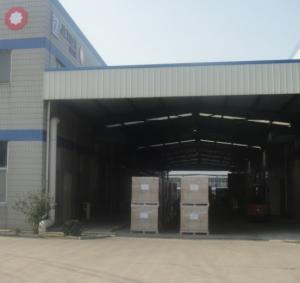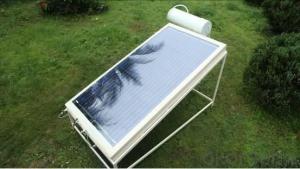Mono Solar Cell 125mm 125 mm 125 mm 0.5 mm
- Loading Port:
- China main port
- Payment Terms:
- TT or LC
- Min Order Qty:
- 40000 watt
- Supply Capability:
- 100000 watt/month
OKorder Service Pledge
OKorder Financial Service
You Might Also Like
Details Of Mono Solar Cell 125mm
Specifications Of Mono Solar Cell 125mm
1.Mechanical data and design
Format | 125 mm × 125 mm ± 0.5 mm |
Thickness | 210 μm ± 40 μm |
Front(-) | 1.6 mm bus bars (silver),blue anti-reflection coating (silicon nitride) |
Back (+) | 2.5 mm wide soldering pads (silver) back surface field (aluminium) |
2.Temperature Coefficient of Cells
Voc. Temp . coef.%/K | -0.35%/K |
Isc . Temp . coef.%/K | +0.024%/K |
Pm. Temp. coef.%/K | -0.47%/K |
3.Electrical Characteristic
Efficiency(%) | Pmpp (W) | Umpp (V) | Impp (A) | Uoc (V) | Isc (A) | FF (%) |
18.35 | 2.841 | 0.532 | 5.342 | 0.631 | 5.67 | 79.41% |
18.20 | 2.817 | 0.53 | 5.319 | 0.631 | 5.64 | 79.16% |
18.05 | 2.794 | 0.527 | 5.301 | 0.63 | 5.63 | 78.77% |
17.90 | 2.771 | 0.527 | 5.259 | 0.629 | 5.62 | 78.39% |
17.75 | 2.748 | 0.526 | 5.224 | 0.629 | 5.61 | 77.88% |
17.60 | 2.725 | 0.524 | 5.201 | 0.629 | 5.59 | 77.50% |
17.45 | 2.702 | 0.52 | 5.196 | 0.629 | 5.586 | 76.90% |
17.30 | 2.678 | 0.516 | 5.183 | 0.626 | 5.577 | 76.71% |
17.15 | 2.655 | 0.513 | 5.175 | 0.623 | 5.565 | 76.58% |
17.00 | 2.632 | 0.51 | 5.161 | 0.622 | 5.559 | 76.12% |
16.75 | 2.593 | 0.508 | 5.103 | 0.615 | 5.477 | 76.98% |
16.50 | 2.555 | 0.506 | 5.047 | 0.608 | 5.396 | 77.88% |
4.Intensity Dependence
Advantage Of Mono Solar Cell 125mm
1: high quality cell, Level A cell (16.50%—18.35%)
2: Dimensione:125*125mm Diagonal:150mm / 165mm
Dimensione:156*156mm Diagonal:200mm
3: Qualified certification: TUV,CE certification.
4: Warranty: five years for whole unit
Usage/Application Of Mono Solar Cell 125mm
Packaging & Delivery Of Mono Solar Cell 125mm | |
Packaging Detai | Packaging Detail:Export Carton and Pallet or under customer request. |
Delivery Detail:10-20days | |
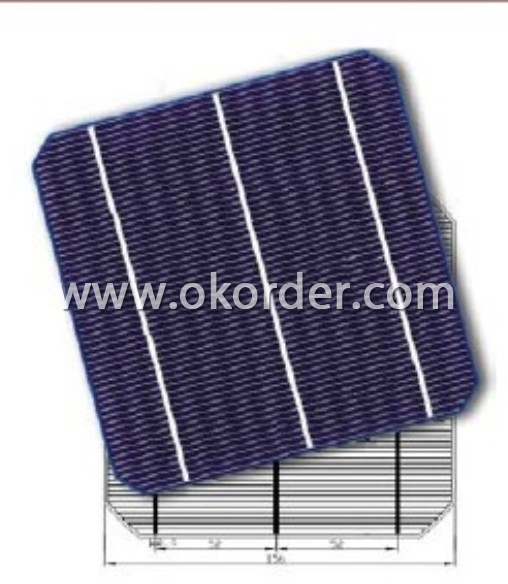
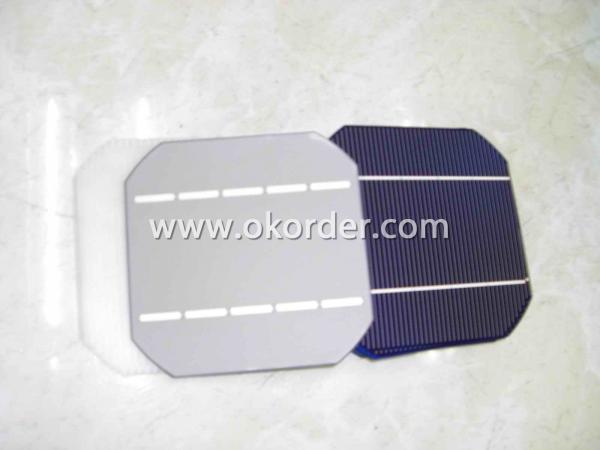
Converting the sun’s radiation directly into electricity is done by solar cells. These cells are made of semiconducting materials similar to those used in computer chips. When sunlight is absorbed by these materials, the solar energy knocks electrons loose from their atoms, allowing the electrons to flow through the material to produce electricity. This process of converting light (photons) to electricity (voltage) is called the photovoltaic effect.
When photons are absorbed by matter in the solar cell, their energy excites electrons higher energy states where the electrons can move more freely. The perhaps most well-known example of this is the photoelectric effect, where photons give electrons in a metal enough energy to escape the surface. In an ordinary material, if the electrons are not given enough energy to escape, they would soon relax back to their ground states. In a solar cell however, the way it is put together prevents this from happening. The electrons are instead forced to one side of the solar cell, where the build-up of negative charge makes a current flow through an external circuit. The current ends up at the other side (or terminal) of the solar cell, where the electrons once again enter the ground state, as they have lost energy in the external circuit.
Solar cells, which were originally developed for space applications in the 1950s, are used in consumer products (such as calculators or watches), mounted on roofs of houses or assembled into large power stations. Today, the majority of photovoltaic modules are used for grid-connected power generation, but a smaller market for off-grid power is growing for remote areas and developing countries.
Given the enormous potential of solar energy, photovoltaics may well become a major source of clean electricity in the future. However, for this to happen, the electricity generation costs for PV systems need to be reduced and the efficiency of converting sunlight into electricity needs to increase. To achieve this, the Commission supports photovoltaics development since many years by funding research projects and facilitating cooperation between stakeholders.
- Q:Can solar cells be used on vehicles?
- Yes, solar cells can be used on vehicles. They can be integrated into the design of vehicles to harness solar energy and convert it into electricity to power various components such as lights, air conditioning systems, and even electric motors in hybrid or electric vehicles. This helps reduce reliance on fossil fuels and makes vehicles more sustainable and environmentally friendly.
- Q:Can solar cells be used for powering drones?
- Yes, solar cells can be used for powering drones. By converting sunlight into electricity, solar cells can provide a renewable source of power to drones, reducing the need for traditional batteries and increasing flight duration. Additionally, solar-powered drones have the potential to operate for extended periods without the need for frequent recharging, making them more sustainable and cost-effective in various applications.
- Q:Is it complicated to make a solar cell work well?
- It is quite complicated to make the sun power generate the power we need.
- Q:Can solar cells be used in water?
- Yes, solar cells can be used in water. However, it is important to note that the efficiency of solar cells decreases when submerged in water due to reduced sunlight penetration. Additionally, precautions must be taken to ensure the waterproofing and insulation of the solar cells to prevent any damage or electrical hazards.
- Q:Can solar cells be used in disaster relief efforts?
- Yes, solar cells can be used in disaster relief efforts. Solar cells provide a reliable and sustainable source of electricity, which is crucial in disaster-stricken areas where power infrastructure is damaged or non-existent. Solar panels can be quickly deployed to provide immediate access to electricity for emergency services, communication devices, medical equipment, and lighting in disaster response centers, hospitals, and temporary shelters. They are also cost-effective and environmentally friendly, offering long-term benefits for affected communities during the recovery and rebuilding process.
- Q:How do solar cells perform in areas with high levels of water pollution?
- Solar cells may be adversely affected in areas with high levels of water pollution. The presence of pollutants, such as chemicals or particles, in the water can reduce the amount of sunlight reaching the solar cells, thereby decreasing their efficiency. Additionally, water pollution can lead to the accumulation of dirt, debris, or algae on the surface of the solar panels, further diminishing their performance. Regular cleaning and maintenance are essential in such areas to ensure optimal functioning of solar cells.
- Q:Can solar cells be used for powering medical devices?
- Yes, solar cells can be used for powering medical devices. Solar cells convert sunlight into electricity, which can be utilized to power various medical devices such as portable monitors, insulin pumps, hearing aids, and even prosthetic limbs. This renewable energy source allows for greater portability and independence, especially in remote or resource-limited areas where access to electricity may be limited.
- Q:Can solar cells be used in developing countries?
- Yes, solar cells can be used in developing countries. In fact, they are increasingly being used as a cost-effective and sustainable solution to address the energy needs of these countries. Solar cells provide access to electricity in remote areas where traditional grid infrastructure is unavailable or unreliable. They can power homes, schools, healthcare centers, and other essential services, improving living conditions and fostering economic development. Additionally, solar energy is abundant and renewable, reducing dependence on fossil fuels and mitigating climate change impacts.
- Q:How much do solar cells cost?
- The cost of solar cells can vary depending on various factors such as the type and size of the solar cell, location, installation costs, and any additional equipment needed. On average, solar cells can range from a few hundred dollars for small, portable units to thousands of dollars for larger, more efficient panels. It is important to consider the long-term savings and benefits of solar energy when evaluating the cost.
- Q:How do solar cells generate electricity at night?
- Solar cells do not generate electricity at night as they rely on sunlight to convert photons into electrical energy.
1. Manufacturer Overview |
|
|---|---|
| Location | SanShui City, Guang Dong, China. |
| Year Established | 2009 |
| Annual Output Value | Above 10 billion RMB |
| Main Markets | Mid East;Western Europe;North America;Southeast Asia |
| Company Certifications | TUV ISO9001;SGS |
2. Manufacturer Certificates |
|
|---|---|
| a) Certification Name | |
| Range | |
| Reference | |
| Validity Period | |
3. Manufacturer Capability |
|
|---|---|
| a)Trade Capacity | |
| Nearest Port | Zhuhai, Foshan |
| Export Percentage | 0.4 |
| No.of Employees in Trade Department | about 600 |
| Language Spoken: | English;Chinese; |
| b)Factory Information | |
| Factory Size: | 66666.7m2 |
| No. of Production Lines | 12 |
| Contract Manufacturing | OEM Service Offered;Design Service Offered |
| Product Price Range | USD 0.3-0.45/Wp |
Send your message to us
Mono Solar Cell 125mm 125 mm 125 mm 0.5 mm
- Loading Port:
- China main port
- Payment Terms:
- TT or LC
- Min Order Qty:
- 40000 watt
- Supply Capability:
- 100000 watt/month
OKorder Service Pledge
OKorder Financial Service
Similar products
New products
Hot products
Hot Searches
Related keywords
